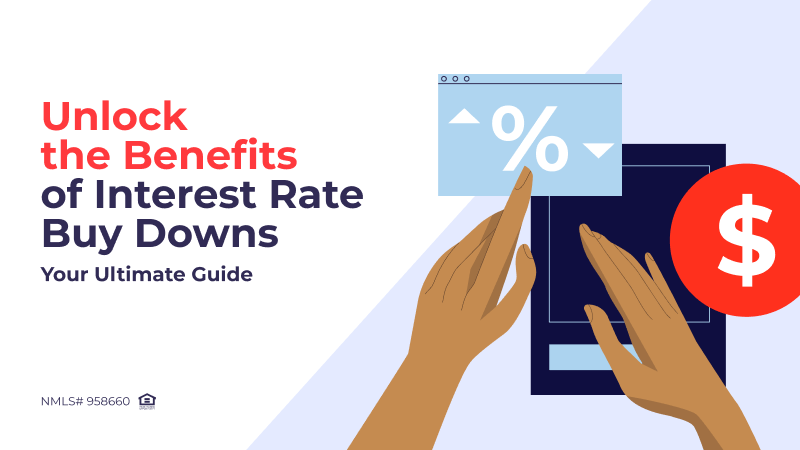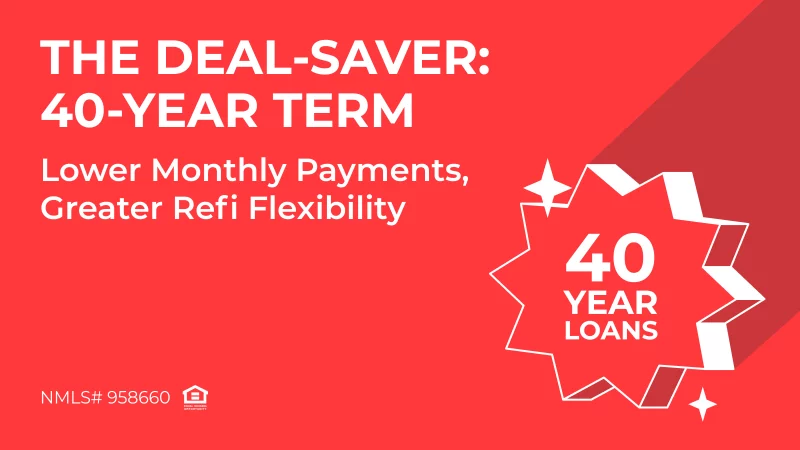Mortgage brokers need to understand how to advise clients and homeowners about interest rate buydown if they are trying to help them save money by refinancing. Why? This method, involving pre-paid interest for a lower rate over a loan’s life, can reduce monthly payments and overall interest costs. Such savings make homeownership more attainable and can offer a substantial financial advantage, particularly with fluctuating interest rate.
Interest rate buydowns not only make the housing market more accessible but also allow homeowners to adjust their mortgages to suit their current financial situations. Whether in a buyer’s or seller’s market, knowing how to effectively use buydowns will help borrowers to make choices that can lead to long-term savings and improved financial health. Refinancing the borrowers existing loan, may increase total finance charges over the life of the loan.
This guide simplifies the concept of interest rate buydowns. We will explore their benefits, limitations, and practical applications. With this knowledge, readers can confidently navigate their mortgage options, aligning their decisions with their financial goals.
What is an Interest Rate Buydown?
Struggling with a loan scenario?
Get a solution in 30 minutes!
Fill out the short form and get your personal offer
Submit a Scenario
Interest rate buydown is a strategic financial maneuver that helps to lower the interest rate on a mortgage. By paying upfront fees, known as points, at the time of closing, borrowers can secure a reduced interest rate either for a predetermined portion of the loan’s lifespan or for its entirety. This upfront payment essentially pre-pays some of the loan’s interest, offering immediate and potentially long-term financial benefits. There are two main categories of interest rate buydowns: temporary and permanent.
Temporary Buydowns
Temporary buydowns are particularly attractive for borrowers looking for immediate relief on their monthly mortgage payments. Under this arrangement, the interest rate is reduced for a specific initial period, typically 1 to 3 years, after which it reverts to the loan’s original rate. This type of buydown can be an effective tool for managing short-term financial planning. It provides borrowers with lower payment obligations during the early years of their mortgage when other homeownership costs like repairs and furnishings may be higher.
Permanent Buydowns
Permanent buydowns offer a long-term approach to reducing mortgage costs. By paying points upfront, the borrower secures a reduced interest rate that applies for the life of the loan. This option is particularly appealing for those planning to stay in their homes for many years or the entire duration of the mortgage, as the initial cost of the buydown can be recouped through ongoing interest savings.
A permanent buydown can significantly impact the total interest paid over the life of the loan, potentially saving borrowers tens of thousands of dollars. This strategy requires a larger initial investment at closing but can be financially beneficial, offering predictable, reduced monthly payments that make budgeting easier and can free up funds for other investments or expenses.
How Interest Rate Buydown Works
Understanding the mechanics of interest rate buydowns is crucial for anyone looking to secure a mortgage. By being aware of how buydowns function, borrowers can make informed decisions that potentially save them a significant amount of money.
The Mechanics of Interest Buydown
The principle behind buydowns is straightforward: borrowers pay an upfront fee, known as points, to reduce their mortgage interest rate. Each point is equivalent to 1% of the loan amount and results in a reduction of the interest rate, which directly affects the monthly mortgage payment amount. This transaction is typically conducted at the closing of the mortgage and represents a prepayment of interest that reduces the lender’s risk, allowing for a lower interest rate to be offered.
For example, if a borrower takes out a $300,000 mortgage and pays 2 points ($6,000) upfront, they can lower their interest rate, resulting in lower monthly payments. The exact reduction in the interest rate varies by lender and market conditions but is generally around 0.25% per point.
Types of Buydowns Explained
Buydowns can be categorized into several types, each with unique benefits:
- 1-0 Buydown. In this scenario, the borrower’s interest rate is reduced by 1% for the first year of the loan. This can provide significant initial savings, particularly useful for borrowers looking for lower payments when they adjust to homeownership expenses.
- 2-1 Buydown. The interest rate is reduced by 2% in the first year and 1% in the second year before reverting to the original rate in the third year. This graduated approach helps borrowers gradually adjust to the full mortgage payment amount.
- 3-2-1 Buydown. This option reduces the interest rate by 3% in the first year, 2% in the second year, and 1% in the third year. It’s particularly advantageous for those expecting their financial situation to improve over a few years.
Costs Associated with Buydowns
The cost of a buydown is directly tied to the loan amount and the reduction in the interest rate sought. This upfront fee can be paid by the buyer, the seller, or even the builder in some cases, often as part of negotiations in the home buying process. Sellers or builders may offer to pay for buydown points as an incentive for purchase or to close a deal more quickly.
Calculating the cost-effectiveness of a buydown involves comparing the upfront costs against the monthly savings and the expected duration of loan ownership. For many, the initial expense can be justified by the long-term savings on interest, making buydowns a smart financial strategy.
Advantages and Disadvantages of Interest Rate Buydown
Interest rate buydowns offer an attractive proposition for many borrowers. However, like any financial strategy, they come with their own set of pros and cons that must be carefully weighed.
Pros of Buydowns
Immediate Reduction in Monthly Payments. One of the most immediate benefits is the reduction in monthly mortgage payments. This can make homeownership more accessible for borrowers in the short term and can provide significant financial relief during the early years of a mortgage.
Long-term Savings on Interest. Over the life of the loan, the savings on interest can be substantial. For those who opt for a permanent buydown, this means paying less money to the lender in interest over the term of the mortgage. Even temporary buydowns, while offering a shorter period of reduced payments, can still offer considerable savings during the initial years of the loan.
Increased Affordability. By lowering monthly payments, buydowns can make more expensive homes more accessible to buyers. This can be advantageous in competitive housing markets.
Flexibility. Some buydown agreements allow for flexibility, such as the option for the seller to contribute to the buydown as part of the negotiation process.
Cons of Buydowns
Upfront Costs. The most significant downside to interest rate buydowns is the upfront cost. Paying points at closing means that borrowers must have additional cash on hand. Sometimes it can be a substantial amount, depending on the size of the loan and the terms of the buydown.
Complexity. The terms and conditions of buydowns can be very complex. This complexity requires borrowers to conduct thorough research or consult with financial advisors to ensure a buydown is in their best interest.
Potential for Not Recovering Costs. For those who sell their home or refinance their mortgage early in the loan term, there’s a risk that the costs of the buydown will not be fully recouped through the savings on interest. This makes buydowns less ideal for individuals who do not plan to stay in their homes for a long period.
Evaluating If an Interest Buydown is Right for You
Deciding whether an interest rate buydown is the right choice depends on several factors.
Considerations Before Choosing a Buydown
Financial Situation. Your current financial situation and projected future income are crucial considerations. If you have the cash on hand for upfront costs and are looking for long-term savings, a buydown might be a good choice.
Housing Market Trends. The state of the housing market can influence whether a buydown makes sense. In high-interest rate environments, buydowns can be particularly beneficial.
Loan Duration. How long you plan to stay in the home or keep the loan can affect whether the buydown is worth it.
Calculating Your Break-even Point
Understanding when you’ll break even on a buydown is critical. Here’s a simplified step-by-step guide:
- Calculate Total Upfront Costs. This includes the cost of the points purchased at closing.
- Monthly Savings. Determine how much less you’ll be paying each month as a result of the buydown.
- Break-even Calculation. Divide the total upfront costs by the monthly savings. This will give you the number of months it will take to recoup the initial investment in the buydown.
Considering these factors and calculations will help you make a decision about whether an interest rate buydown aligns with your financial goals and circumstances.
Buydowns in Different Mortgage Scenarios
Struggling with
a loan scenario?
Get a solution in 30 minutes! Fill out
the short form and get your personal offer
Submit a Scenario
Interest rate buydowns can be a strategic tool across various mortgage scenarios, each with unique benefits and considerations.
Buydowns for First-Time Homebuyers
First-time homebuyers often find buydowns attractive for their reduction in monthly payments. A temporary buydown can lower initial payments, providing breathing room for new homeowners adjusting to the costs associated with their first home.
Buydowns for Refinancing
Homeowners considering refinancing can also benefit from buydowns. When interest rates drop, refinancing with a buydown can further reduce monthly payments and overall interest costs. This strategy can be appealing for those looking to lower their payments or pay off their mortgage faster.
Buydowns in Seller’s vs. Buyer’s Markets
The appeal and strategy of buydowns can shift based on market conditions. In a seller’s market, sellers might offer buydowns as an incentive to attract buyers. Conversely, in a buyer’s market, purchasers may have the leverage to negotiate for buydowns to secure better financing terms.
The Process of Obtaining an Interest Rate Buydown
Securing an interest rate buydown involves several steps, starting with a discussion with your lender about the options available. Borrowers should compare the long-term benefits of reduced interest payments against the upfront costs of buying down the rate. Once a decision is made, the buydown is typically arranged during the mortgage application process and finalized at closing, where the buyer pays the agreed-upon points to lower their interest rate.
Alternatives to Buydowns
While buydowns offer one way to reduce mortgage costs, other strategies exist. Refinancing to a lower interest rate without a buydown can also decrease monthly payments and total interest. Making extra principal payments can reduce the loan balance faster, shortening the loan term and decreasing the total interest paid. Each of these alternatives has its benefits and considerations. That’s why it is essential for borrowers to evaluate all options in the context of their financial goals and circumstances.
Conclusion
Interest rate buydowns present a strategy for potential homeowners and those who consider refinancing. By understanding the concept of buydowns, borrowers can make decisions tailored to their unique situations. Whether it’s buying a first home or refinancing, buydowns offer a flexible tool for achieving financial goals.
However, it’s essential for borrowers to weigh the immediate advantages against the upfront costs and to consider their long-term housing and financial plans. Alternative strategies can also help reduce mortgage costs and should be evaluated in tandem with buydown options. Ultimately, a thorough analysis and understanding of one’s financial position, market conditions, and mortgage terms will guide borrowers toward the most beneficial mortgage strategy.




